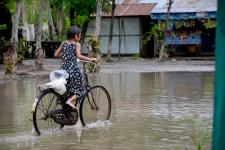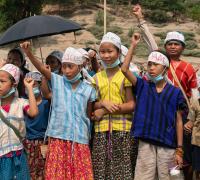Climate-vulnerable Myanmar absent from COP28 negotiations

World leaders, government representatives and delegates from countries all over the world are in Dubai for the 28th meeting of the United Nations climate change summit (COP 28). For the third year in a row, missing from these conversations is an official representative from Myanmar – a country both extremely vulnerable to climate change and also experiencing violent civil conflict. But what does it mean, when one of the world’s most vulnerable countries to climate change is unable to attend these meetings? Does it matter? Are there alternative options? How can world leaders better support the needs of vulnerable communities in conflict settings?
Understanding Myanmar’s absence from COP28
Before answering these questions, it’s important to understand why Myanmar hasn’t been represented at the most recent COP summits. In February 2021, the Myanmar military staged a coup, instituting a violent and repressive order which saw widespread resistance that has resulted in a revolutionary conflict, forcing more than 1.95 million people from their homes. Nine months after the coup, the Myanmar military attempted to send a delegation to the COP26 Summit in Glasgow in Nov 2021. However, they were denied entry after pro-democracy and Indigenous groups complained to the credentials committee of the United Nations Framework Convention on Climate Change (UNFCCC). The parallel opposition National Unity Government (NUG), which consists of elected politicians and representatives from a number of ethnic minorities, simultaneously tried to get its own delegation accepted to COP26, but was also rejected.
The rejection of the junta was described at the time by Indigenous groups and the NUG, as ‘a victory for the people of Myanmar.’ Alongside maintaining the position of the pro-democracy Ambassador Kyaw Moe Tun as the official Myanmar representative in the UN General Assembly, this signalled that the world community did not recognise the military junta. If, on the other hand, the junta had participated in COP26, there were fears that it would use this to burnish its international reputation, all the while committing abuses against the population and predatory exploitation of the environment.
At COP27 and again this year at COP28, the junta was not nominated by the UNFCCC to attend, but neither was the NUG. This is despite the fact that several countries, including the EU Parliament, now recognise the NUG as Myanmar's legitimate representative. Delegates from Myanmar have been able to participate in side events at both COP26 and again now at COP28, present in the form of an alliance of Indigenous peoples. However, while their participation is very important, these groups hold much less weight than official delegates of countries who have signed or are ‘parties’ to the UNFCCC. Given that conflict-affected countries, often with authoritarian regimes, are among the most climate-fragile, should the UN not consider accepting opposition governments, Indigenous representatives, and other non-state actors at the negotiating table in special cases like Myanmar?
Why does a seat at COP matter?
In 2021, the UN’s Intergovernmental Panel on Climate Change (IPCC) highlighted the significant needs of communities facing climate change in conflict settings. A wide body of research identifies climate change as a ‘threat multiplier’ that, in combination with socio-political factors like poverty, state incapacity and inequality, can intensify violent conflict and poses significant risks to national and international security. Since 2018, the Climate Security Mechanism has provided multidisciplinary support to Member States, regional organisations and UN entities to better understand the linkages between climate, peace and security. Recent reports in the lead up to COP28 from the World Food Programme, the International Committee of the Red Cross and the International Rescue Committee also highlight the urgent need to prioritise COP negotiations around the needs of communities facing climate change in fragile settings.
In the 2021 Global Climate Risk Index, Myanmar is ranked 2 out of 183 countries most vulnerable to extreme weather events. With more frequent heat waves, floods, cyclones and droughts that impact production, food security and land scarcity, climate change poses a severe and urgent threat to people’s livelihoods, food security and sustainable development in Myanmar. Since the coup, widespread conflict is driving new waves of displacement and deepening people’s vulnerability to climate change. In a country where more than seventy per cent of the population relies on the environment and agricultural production for their everyday needs, these shifts have hit rural and ethnic minority communities especially hard. As demonstrated in May this year after a devastating cyclone hit the coast of Rakhine state, the military junta uses their relationships with international humanitarian organisations to orchestrate displays of generosity and efficient disaster management, but without aid reaching the most vulnerable. Research by the MyCClimate project reveals the devastation inflicted on local communities in Rakhine, and the lack of support for the long-persecuted Rohingya in particular.
The coup has also significantly endangered the lives and customary livelihoods of Indigenous communities who live in resource-rich areas and now face ‘climate collapse’. Alongside devastating air strikes from the Myanmar military, people in these areas are made further vulnerable by military-driven extractive activities and the proliferation of war economies. In the absence of oversight mechanisms, civil society and environmental organisations report a rapid increase in unregulated mining, which is polluting waterways, decimating forests, destroying mountains, and causing landslides and changes to fragile ecosystems. In addition to threatening local land rights and livelihoods, the military’s plans to revive controversial hydropower dams and palm oil plantations will heavily disturb important riverine ecosystems, destroy natural forests and threaten indigenous communities traditional livelihoods. As one Karen environmental activist Naw Eh Htee Wah described to us in an interview, it is vital that the world recognises the Myanmar military as both a brutal dictatorship, but also a critical danger to the environment.
Alternatives for a more inclusive COP?
The situation in Myanmar raises an important question: should the UNFCCC rethink its state-centred COP set-up for countries where the regime in the capital is not recognised by its people, or even the UN? This would mean providing a platform in COP negotiations for local forces that take climate change seriously, recognising these forces as ‘parties’.
One of the four ‘paradigm shifts’ articulated by the COP’s President this year is to ‘mobilise for the most inclusive COP’, including working in collaboration with women, Indigenous Peoples and youth. There is also increasing consensus that climate change funding must reach people in conflict zones. The challenge is that with few exceptions, the UN only recognises states, not governments, which effectively excludes alternative delegations from having a seat in high-level negotiations.
Myanmar's situation after the coup is extremely complicated, as it is difficult to determine who the state really is. If the state consists of those who sit in the heavily fortified ministry buildings in the Myanmar capital Naypyidaw, then the junta is ‘the state’. However, the junta holds no legitimacy among the people of Myanmar, nor in the international community and lacks control of much of the country. Many rural areas are now held by a mixture of ethnic resistance organisations and groups coordinated by the NUG. So effectively, Myanmar does not constitute one singular state.
In contrast to the military junta, Indigenous groups, environmental networks, ethnic resistance organisations (EROs) and the parallel NUG government in Myanmar continue to voice the threats posed by climate change in Myanmar and implement activities on the ground. Myanmar has a strong civil society sector and its Indigenous groups are some of the most vocal actors on climate change. Despite the ongoing airstrikes in Myanmar’s southeast, the Karen Environmental Social Action Network (KESAN), for example, continues to co-manage and expand a globally recognised Indigenous-led conservation zone known as the Salween Peace Park. However, as explained in our interview with Karen activist Naw Eh Htee Wah, many community led efforts to support people to mitigate and adapt to climate change face immense difficulties due to the presence of conflict, but also funding shortfalls.
Reports from the World Food Programme show that people living in conflict settings are three times more affected by climate extremes than those in other countries, yet receive the least support. Part of this lack of funding, also comes back to the UN system, its influence on the international development sector and the fact that the majority of climate financing gets channelled through states. While there is increasing rhetorical and policy attention on the need to prioritise funding for climate change initiatives in countries experiencing civil conflict, adaptation and mitigation efforts have remained slow and inadequate and, in many conflict scenarios, generate new risks and vulnerabilities.
Our climate-conflict research in Myanmar at DIIS since the coup has shown that there are a number of initiatives underway on the climate and environmental front among the pro-democracy opposition to the military, Indigenous peoples, and the civilian wings of ethnic resistance organisations. Unlike the Myanmar military, some ethnic resistance organisations (EROs) and their associated state-like governance, justice, forestry, health and education services enjoy high levels of legitimacy. The Karen National Union - Myanmar's oldest ethnic resistance group with control over large areas on the border with Thailand - has long been engaged in forest conservation and biodiversity protection and is currently developing a climate action plan with its civil society sector, including a carbon reduction emissions scheme. Although other EROs are somewhat behind in this development, they are increasingly inspired by the KNU, and are under pressure from their own civil society to scale back mining and deforestation.
In addition, the NUG, and especially its Ministry of the Environment and Natural Resources (MONREC), has started several initiatives for the benefit of the environment, such as taxation and restrictions on deforestation. It is also doing climate change awareness campaigns. However, an official of the NUG’s MONREC explained in an interview that they face challenges in both implementing activities on the ground and finding the support and funding to revise Myanmar’s Climate Change policy and National Determined Contributions (NDC) in line with the pro-democracy federal democratic charter. “We are completely blocked from participating in international forums on climate change and we have very few partners willing to support our activities.” he explained. “There needs to be more flexibility in the UN system for cases like Myanmar.”
Climate financing beyond the ‘state’
The state-centric set-up of the UN means that the largest share of global climate finance currently goes through states. But in conflict-affected contexts with illegitimate regimes, this is risky and funds often fail to reach the most vulnerable communities. Funding and technical advice should instead be targeted in flexible ways at groups which are actively engaged in climate-related initiatives on the ground and which have a track record in working with communities and environmental protection.
The largest share of global climate finance currently goes through states, but, as highlighted above, this is deeply problematic in countries like Myanmar. Implementation needs to shift away from top-down, state-centric and purely technical solutions to people-centred approaches with flexible funding and reporting requirements that fit a volatile and insecure context. The international community also needs to ensure that the drivers of conflict are considered within climate interventions, especially since conflict-sensitive climate adaptation needs to be part of the solution. Instead of being constrained by state-based solutions, climate financing should target assistance at local CSOs, Indigenous-led groups and non-state resistance organisations who, like in Myanmar, have an existing track record for working with communities on the ground and in-depth experiences with environmental protection. The calls at COP28 for increased attention to conflict-affected countries will hopefully contribute to such a shift, and ensure that countries like Myanmar, which do not have an official seat at the COP, are not forgotten.
A shorter version of this article was first published at thethirdpole.net
DIIS Experts



